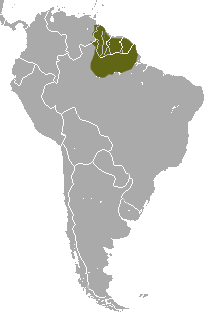黑蜘蛛猴
黑蜘蛛猴(学名:Ateles paniscus),又称为朱颜蜘蛛猴、红脸蜘蛛猴,是一种蜘蛛猴,栖息于南美洲北部的雨林之中。
| 黑蜘蛛猴[1] | |
|---|---|

| |
| 饲养于法国猴谷野生动物公园的黑蜘蛛猴 | |
| 科学分类 | |
| 界: | 动物界 Animalia |
| 门: | 脊索动物门 Chordata |
| 纲: | 哺乳纲 Mammalia |
| 目: | 灵长目 Primates |
| 科: | 蜘蛛猴科 Atelidae |
| 属: | 蜘蛛猴属 Ateles |
| 种: | 黑蜘蛛猴[1] A. paniscus
|
| 二名法 | |
| Ateles paniscus | |

| |
| 分布地区 | |
| 异名 | |
|
Simia paniscus Linnaeus, 1758 | |
由于受到盗猎以及栖息地破坏的威胁,黑蜘蛛猴目前在国际自然保护联盟濒危物种红色名录被列为易危物种。
描述
编辑黑蜘蛛猴具有长而黑的毛发,面部则呈红或粉红色,上面由较短而白的毛覆盖[4]。刚出生的幼猴面部呈黑色,随着年纪增长才逐渐转淡[4]。黑蜘蛛猴不具有明显的两性异形,雄性平均体长为55.7厘米(21.9英寸),雌性则为55.2 cm(21.7英寸)[4];雄性体重约为9.1千克(20磅),雌性则为8.4千克(19磅)[2]。它们的尾巴具有抓握能力,四肢长而强健。
行为
编辑黑蜘蛛猴群呈现裂变融合社会结构,在夜晚时会形成多达30只个体的群体,于白天时则会分散为小群体移动或觅食。夜晚时聚集而成的猴群英文称为“Band”,这个群体多半由雌性个体与它们的后代组成,并有少数的雄性个体保护它们的安全。群体的分布范围可达255公顷(630英亩),其中约220 ha(540 acre)为适宜的栖息地[2]。
黑蜘蛛猴为杂食性,以白蚁、蛴螬、叶片、花朵、莓果与水果为食。妊娠期为226–232天,于4-5岁时断奶并达到性成熟,圈养个体寿命可达33岁[2][4]。
栖息与分布地
编辑黑蜘蛛猴为狭栖性物种(Habitat Specialist),仅栖息于北巴西、苏里南、圭亚那、法属圭亚那与委内瑞拉地区[2]未开发的原始雨林[4]。由于黑蜘蛛猴十分擅长攀爬与跳跃,它们多半栖居于雨林的上层,并以树冠层的食物为食[4]。
保护现况
编辑黑蜘蛛猴的栖息地现已被划为保护区[2],并受到1973年所列的亚马逊动物保护条例(Amazon Animal Protection Act)所保护。黑蜘蛛猴在国际自然保护联盟濒危物种红色名录中被列为易危物种[2]。
参考文献
编辑- ^ Groves, C.P. Wilson, D.E. & Reeder, D.M. , 编. Mammal Species of the World: A Taxonomic and Geographic Reference (3rd ed.). Baltimore, Maryland: Johns Hopkins University Press. 2005: 151. ISBN 978-0-8018-8221-0. LCCN 2005001870. OCLC 62265494. OL 3392515M. NLC 001238428.
- ^ 2.0 2.1 2.2 2.3 2.4 2.5 2.6 Mittermeier, R.A.; Rylands, A.B.; Boubli, J. Ateles paniscus. The IUCN Red List of Threatened Species. 2019: e.T2283A17929494.
- ^ Linnaeus, Carl. Systema naturæ. Regnum animale. 10th. 1758: 26 [19 November 2012]. (原始内容存档于2012-11-08).
- ^ 4.0 4.1 4.2 4.3 4.4 4.5 Cawthon Lang, K. A. Black spider monkey (Ateles paniscus). 10 April 2007 [2021-03-03]. (原始内容存档于2020-08-07).
延伸阅读
编辑- Neotropical Rainforest Mammals (1997), Louise Emmons and Francois Feer (英语)
- MacDonald, David W. (2006). Encyclopedia of Mammals, Volume 2. Facts on File. p. 333. (英语)
- Burnie, David and Wilson, Don (2001). Animals. DK Publishing, Inc. p. 123. (英语)
- Stewart, Melissa (2008). New World Monkeys. Lerner Publications Company. p. 27-29 (英语)
- Redmond, Ian (2008). The Primate Family Tree. Firefly Books Ltd. p. 97 (英语)
